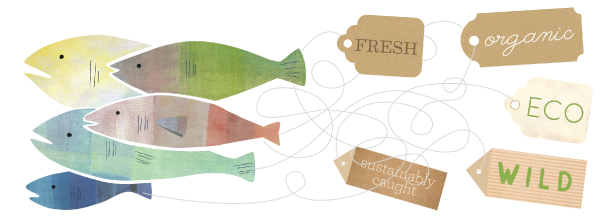Eco-labels were designed to simplify the process by doing the vetting for us. But judging fish isn’t easy, and these programs are fraught with design and execution flaws that severely limit the effectiveness of the whole movement.
Challenges
Monterey Bay Aquarium, Blue Ocean Institute, NOAA, Marine Stewardship Council—these are just a few of the institutions offering various guides and eco-labels. Discrepancies in how species are evaluated (the type of primary research conducted—if at all, the frequency of updates, the method for setting criteria, and the cost of certification) lead to conflicting recommendations and controversy. Such confusion hinders fishers and farmers, who don’t know which label or certification to pursue, and disempowers fish buyers, who must decipher the complexity to understand which product is best to buy.
Most fish left behind
Despite years of effort, only a very small fraction of global wild catch (<20%) and aquaculture product (<5%) are ever certified. The high cost of certification processes, opacity of the supply chain, and demand focused on a limited number of popular species (salmon, shrimp) mean most fisheries are left in the dust when it comes to certification or eco-labeling schemes.
Beyond fishers’ control
Programs evaluate the behaviors of the fishers and the health of the stock. While this might sound good in theory, in practice it means that impacts beyond fishers’ control—such as climate change, oil spills, and historic poor fisheries management—can prevent a fishery from receiving certification; in fisheries with no hope of counteracting these effects, fishers have little incentive to switch to more sustainable fishing methods.
Little incentive for fishers
Fishers bear the cost of certification, which can reach up to $250,000 USD, with little evidence that the expensive label will lead to any price premiums.
Comparing apples, oranges, and avocados
Some ecolabels, such as Monterey Bay Aquarium’s Seafood Watch, have extensive, transparent, third-party-reviewed, science-based criteria; others keep their methodologies closer to the vest. All are subjective at some level in terms of what they choose to define as good or bad and the cut offs for different categories.”
Higher demand, lower bar
Increasing demand for certified sustainable seafood outpaces supply. Critics argue that private certification programs have lowered the bar on their standards to push more sustainable product to market. Auditors may simply note a fishery or farm is “in process of compliance” with very little verification; these same auditors are incentivized to pass a farm/fishery because they are often subsequently brought in as fisheries consultants for annual reviews.
Opportunities
Power at the point of purchase
The plethora of guides requires a guide for the guides. Platforms such as FishChoice help sort all the conflicting information and provide direct, convenient access for purchasers to then act. Opportunities to effectively aggregate, integrate, and embed all this information at the point of purchase would empower retailers and consumers, and drive more demand for sustainable product down the supply chain.
Storied Fish
“Sustainability” can mean so many myriad things, it has ultimately become meaningless. By failing to capture the story behind the fish, certification programs miss the boat in their effort to engage consumers. Every fish has a tale. Detailed story—the fishers who caught the fish, the boat that hauled the net, the waters or farm it came from—allows consumers to choose based on whatever priorities they bring to the table: quality, health benefits, local business, etc. Story linked with traceability could lead to better values, garnering better price premiums in the market.





